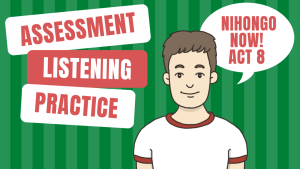Listening Comprehension
Instruction
For each of the following, read the context, listen to the audio, and then answer the questions. The audio may include unfamiliar expressions. If you hear something unfamiliar, rely on what you know to choose the correct answer.
Volume 1
| ACT 1
ACT 2 ACT 3 ACT 4 ACT 5 ACT 6 |
Volume 2
| ACT 7
ACT 8 ACT 9 ACT 10 ACT 11 ACT 12 |
Volume 3
Volume 4
Frequently Asked Questions
Where is Listening Comprehension?
The context and comprehension questions are found in the Hyooka (Assessment) section found at the end of each ACT in the Activity Book.
Where can I find the answers?
Answers are found in the Appendix of the Activity Book. Due to copyrights, answers are not provided in the YouTube video. However, if there are questions you need extra support with, you may leave a question or in the YouTube videos. Comments are also welcome!
What are the dialogues about?
Many items in the listening comprehension sections provide additional back stories about the characters in NOW!, which you might find very interesting in connecting the dots! For instance, you will find more about their social and personal lives.
What’s the difference between the YouTube video files and audio files?
The content is the same. The YouTube videos are created upon requests by learners who wanted to slow down the speed or make use of the subtitles.
What can I do if I find the audio too fast for me to understand it?
Before you start listening to each item, be sure to check the context and what kind of questions you are going to answer. Guess what kind of vocabulary and grammar patterns you might hear beforehand. As you listen, be on the look out for new vocabulary and grammar patterns introduced in each ACT. The dialogues make use of many of the vocabulary introduced in each ACT, which includes the additional vocabulary marked with a “+” sign. You may also find it useful to make use of the play speed as well as the subtitles functions available in the YouTube videos.
Why are unfamiliar expressions used sometimes?
Unfamiliar expressions are included purposefully (and sparingly) to help you prepare for real life situations in which you may have to constantly deal with encountering unfamiliar expressions. You should still be able to understand and answer the questions based on contextual cues and other expressions that have been introduced in the textbook.
![]()













